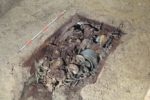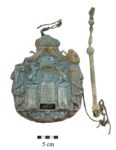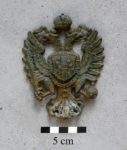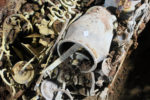 Archaeologists have discovered a treasure chest of Judaica in the 18th century Old Synagogue of Wieliczka, southern Poland. A team from the Institute of Archaeology of Jagiellonian University dug a narrow test trench next to an interior wall when they encountered the remains of decayed wooden box with metal objects visible. They extended the trench to explore further and found a literal treasure chest full of hundreds of metal objects that had been nested inside each other and packed closely together.
Archaeologists have discovered a treasure chest of Judaica in the 18th century Old Synagogue of Wieliczka, southern Poland. A team from the Institute of Archaeology of Jagiellonian University dug a narrow test trench next to an interior wall when they encountered the remains of decayed wooden box with metal objects visible. They extended the trench to explore further and found a literal treasure chest full of hundreds of metal objects that had been nested inside each other and packed closely together.
 The wooden crate was approximately 30 inches high, 28 inches wide and 50 inches long. It contained about 350 objects, most of religious significance, from the 19th century. The contents include pieces of four or five brass chandeliers, a silver goblet decorated in a floral motif, five silver candlesticks (two of them Hanukkah), a large metal vessel (probably tin), two large bronze vessels with decorative handles, a silver badge from a Torah with an attached pointer and silver finials from the Torah scroll rods.
The wooden crate was approximately 30 inches high, 28 inches wide and 50 inches long. It contained about 350 objects, most of religious significance, from the 19th century. The contents include pieces of four or five brass chandeliers, a silver goblet decorated in a floral motif, five silver candlesticks (two of them Hanukkah), a large metal vessel (probably tin), two large bronze vessels with decorative handles, a silver badge from a Torah with an attached pointer and silver finials from the Torah scroll rods.
Surprisingly, the treasure chest also contained 18 Austro-Hungarian army cap badges worn by infantry officers. The double-headed eagle crest bears the initials of Emperor Franz Joseph, which dates them to the second half of the 19th century or early 20th century. The demise of the Austro-Hungarian Empire in 1918 led to the creation of the Second Polish Republic out of the territories gobbled up by the Hapsburgs during the partitions of the 18th century, so it seems highly unlikely that the cap badges would have been secreted away with precious holy treasures during World War II. This indicates an earlier burial date.
 It seems incongruous that they would be included in a cache of precious materials from the synagogue itself. Because all of the badges were found at the bottom of the crate, dig supervisor Dr. Michał Wojenka hypothesizes that 18 army caps were used to line the crate and that the textiles rotted away leaving only the badges.
It seems incongruous that they would be included in a cache of precious materials from the synagogue itself. Because all of the badges were found at the bottom of the crate, dig supervisor Dr. Michał Wojenka hypothesizes that 18 army caps were used to line the crate and that the textiles rotted away leaving only the badges.
Wieliczka is one of Poland’s most popular tourist destinations today thanks to its famous labyrinthine cathedral of a salt mine, in continuous operation for 800 years. The Jewish community in Wieliczka dates almost that far back, and indeed several Jews administered the salt mines on behalf of the Hungarian crown for two centuries before laws banning their involvement in the salt trade (and others) were passed in the 16th century. These and subsequent laws prohibiting Jews from doing business and living in Wieliczka were not evenly enforced under the Polish–Lithuanian Commonwealth so in reality there was a continuous Jewish presence.
Come partition and the Habsburg reign, many of the anti-Semitic laws were abolished and Jews were granted rights to live, work and worship in Wieliczka. That notwithstanding, the wave of pogroms that broke out in the Polish territory of the Russian Empire in the late 19th and early 20th century spilled over to Austria-Hungary as well and anti-Jewish riots roiled Wieliczka in 1889 and 1906. The treasure could have been hidden during that period to keep it safe from would-be desecrators, or perhaps in the first winter of World War I when the Russian army occupied Wieliczka during the battle for Kraków in December 1914.
The Jewish community thrived in the interwar period, growing to 4,000 people, half the population of the town. It was obliterated in World War II, most of them slaughtered at Belzec. The few who survived Nazi extermination did not return to Wieliczka. The synagogue building, severely damaged by the Nazis, was used as a warehouse after the war.
 The building is now on the register of historic landmarks but it is in terrible condition. It doesn’t even have a proper roof anymore. Archaeological and architectural examinations have been taking place since last fall in preparation for an ambitious renovation of the synagogue. The field work is essential to the restoration because, believe it or not, there are no extant photographs of the Old Synagogue as it was before its destruction in World War II.
The building is now on the register of historic landmarks but it is in terrible condition. It doesn’t even have a proper roof anymore. Archaeological and architectural examinations have been taking place since last fall in preparation for an ambitious renovation of the synagogue. The field work is essential to the restoration because, believe it or not, there are no extant photographs of the Old Synagogue as it was before its destruction in World War II.
This find is an incredibly huge fluke because the test pit was small and had the team chosen to dig a couple of feet to the left or right, the treasure would never have been found. With so little remaining of Wieliczka’s 600 years of Jewish history, the crate of Judaica is priceless.
So it is possible that the synagogue users spent the interwar era wondering what happened to their prized possessions.
I like the pots. We used to have three like them, made here in eastern Poland. However our darling ginger cat managed to send them all crashing to the floor…
Wow!!
איזה נס. What a miracle.